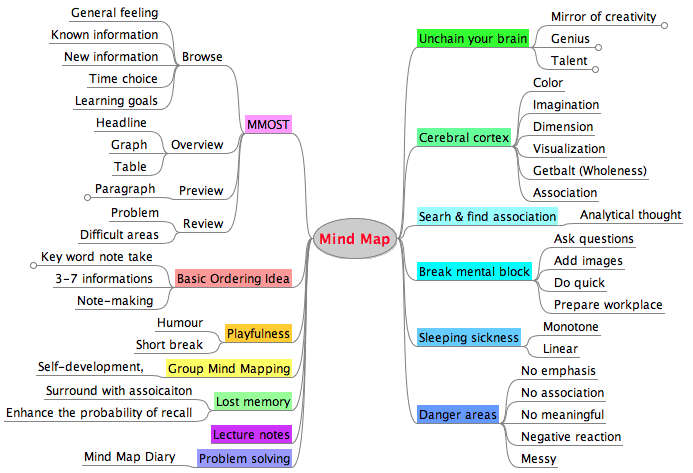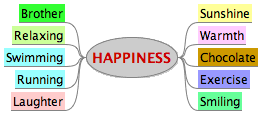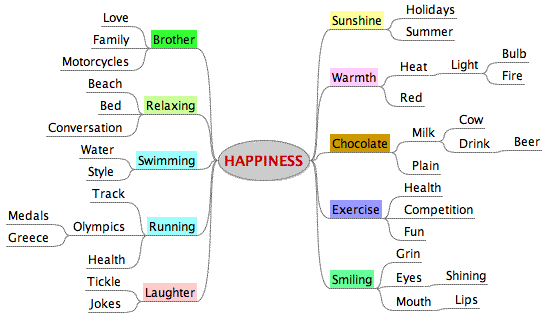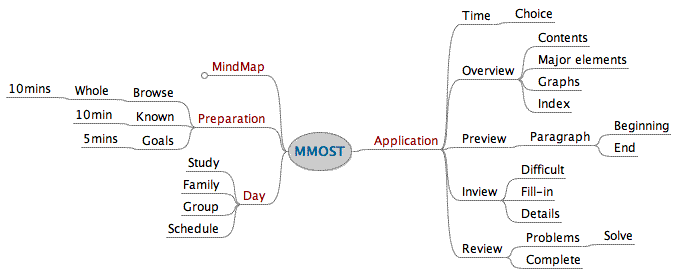The Mind Map Book
|
Cat: SCIPub: 2006#: 0630b |
|
Tony & Barry Buzan |
06z31u/18125r |
Title
The Mind Map Book
Mind Mapの本
Compliler
Tony & Barry Buzan
トニー&バリー・ブザン
Published
2006
2006年
Index
Mind
Map *

Why?
- The Mind Map is called 'the Swiss army knife for the brain, is
an intelligent ground-breaking, note-making technique.
- This technique enhances full capability of cerebral cortex of
human brain, using Color, Image, Visualization, Dimension, Gestalt,
& Association.
- Anyway it is fun and effective to illustrate various idea using
this Mind Map, than using Power Point.
- Power Point is a digital picture-story show, while Mind Map is
a digital Japanese traditional picture scroll.
- Mind Mapは大脳が知的開発やノート作成する際のアーミーナイフと呼ばれる。
- この技術は人間の大脳の能力を、色、イメージ、可視化、次元、全体感、連想を利用して活性化する。
- このMind Mapを利用して様々なアイデアを図示するのは楽しいし効率的である。
- Power Point がデジタル紙芝居とすると、Mind Mapはデジタルな日本の伝統的な絵巻物である。
Summary
要約
>Top 1. Natural Architecture:
- Brain bites:
- In each human brain has an estimated one trillion
brain cells.
- Each dendritic spine/synaptic button contains bundles
of chemical which are the major message-carriers in our
thinking process.
- The Mind Map:
- is your external mirror of your own Radiant Thinking
and allows you access into the vast thinking powerhouse.
- Brain's cerebral hemispheres:
- Left hemisphere appears dominant in:
words, logic, numbers,
sequence, linearity, analysis, list
- Right hemisphere appears dominant in:
rhythm, spatial awareness, gestalt (whole picture), imagination,
daydreaming, colour, dimension
- Development of human intelligence:
- Once human beings realised that they could externalise their
internal mental pictures, development was rapid. The first marks
evolved into pictures.
- As civilization developed, pictures were condensed into symbols
and thence into alphabets and scripts.
- With the development of Western thought and the spreading influence
of the Roman Empire, the transition from picture to letter was
complete.
- Writing is best?
- If writing is indeed the best way of taking in, analyzing and
passing on information, why are so many people having problems
in the field of learning, thinking, creativity and memory?
- >Top Tools used for note-making/taking:
- Analysis was used but its quality was adversely affected by
its linear patterning. Standard notes show an almost complete
absence of:
- Colour
- Image
- Dimension
- Visualisation
- Gestalt (Wholeness)
- Association
- Brain's thinking pattern:
may be seen as a gigantic BAM (Branching
Association Machine) - a super bio-computer with lines of thoughts
radiating from a virtually infinite number of data nodes. This
structure reflects the neuronal networks that make up the physical
architecture of your brain.
- If your brain were fed 10 items of data every second for 100
years, it would still have used less than one-tenth of its storage
capacity. (ad infinitum)
- The more you learn/gather new data in an integrated, radiating,
organised manner, the easier it is to learn more.
1.
自然のアーキテクチャ:
- 大脳バイト:
- 大脳細胞は約1兆個もある
- 各樹状突起やシナプスのボタンは大脳の思考プロセスにおける主要なメッセージ
- Mind Map:
- 放射状思考の外部の鏡であり、巨大の思考発電所へのアクセスを可能にする。
- 大脳半球
- 左脳支配:
言語、論理、数字、連続、線形、分析、表
- 右脳支配:
リズム、空間認識、全体像、創造力、空想、色彩、次元
- インテリジェンスの発達
- 内的な精神による画像を具体化できるようになった後の発達は急激であた。
- 文明の発達に伴い、絵画はシンボルに圧縮され、その後アルファベットやその他の文字に凝縮したいった。
- 西側思考の発展とローマ帝国の影響力のハロ狩り共に、絵画から文字への移動が完成していった。
- 書くことが最善か?
- もし本当に書くことが分析や情報伝達を理解する上で最善とすれば、なぜ多くに人々が学習、思考、創造力、記憶の分野で多くの問題を抱えているのか
- ノートを取る法:
- 線形のパターンでは、ノートをとる上で、うまく分析できない。標準的なノートは以下が欠落している。
- カラー
- イメージ
- 次元
- 可視化
- 全体像
- 連想
- 大脳の思考パターン:
巨大な連想分岐マシーンのように見える。思考の回路が無数のデータノードから放射状につながっている。この構造によって、大脳は、物理的なアーキテクチャを構成する神経ネットワークであることを示している
- 大脳は毎秒10項目のデータを100年間投入しても、まだ全体の要領の1/10以下の使用でしかない。(際限なく)
- 新しいデータを学ぶ場合、いかに統合されて、放射状の関連性の中で収集するかによって、それを学ぶことが容易になる。
>Top 2. Foundations:
 A popular misconception:
A popular misconception:
- the more you educate people, the
more clone-like they will become. Radiate Thinking demonstrates
that the opposite is true; the more you educate people,
the more unique their vast, and growing, networks of associations
become.
- Uniqueness of each individual:
- Every human being is far more individual and unique than
has hitherto been surmised.
- BOI (Basic Ordering Ideas):
are key concepts within which a host of other concepts can be organised.
- Eg: Artefacts > Machines > Vehicles > Cars > Ford
- These power words (BOI) are the key to shaping and steering
the creative process of association.
- The primary ideas are in place so that secondary and tertiary
ideas can follow quickly and easily to facilitate a harmonious
thought structure.
2.
基盤:
- よくある誤解:
- 人々を教育すればするほど、一層クローン的になるというのは誤解である。放射状思考はその反対であることを示している。即ち、人々を教育すればするほど、彼らの連想のネットワークは巨大に成長し、一層ユニークとなる。
- 各個人のユニーク性:
- 各人はいままで推測されていたよりも遙かに個性的でユニークである。
- BOI (基本秩序概念):
これは、基本概念であって、他の概念がその中に組織化する。
- 例:加工品>機械>車両>車>フォード
- これらの強力な言葉 (BOI)は、創造的な連想プロセスを形成する鍵となる。
- 一次概念が正しく設定されると、二次概念、三次概念がすばやく容易に続き、調和のとれた構造が容易になる。
-
>Top Extended original 'Happiness'
exercise:
-

>Top 3. Structure of
Mind Map:
- Three A's of Mind Mapping:
- Accept:
In the first stage, you should set aside any preconceptions you
may have about your mental limitations, and follow the Mind
Mapping laws, exactly, imitating the models given as precisely
as you can.
- Apply:
is the second stage, when you have completed the basic training.
You should create a minimum of 100 Mind Maps, applying the
laws and recommendations.
- Adapt:
refers to the ongoing development of your Mind Mapping skills.
Having practised several hundred pure Mind Maps, this is the
time to experiment with ways of adapting the Mind Map form.
3.
Mind Mapの構造:
- Mind Mapppingの3つのA:
- Accept (受容):
最初の段階は、いかなる精神的な制約に関していかなる先入観も横に置いて、まずMind Mapping作法を学び、できる限り正確にモデルを真似る。
- Apply (応用):
第二段階では、基本的な訓練が終了したので、少なくとも100のMind Mapを作成し、作法と推奨したことを応用する。
- Adapt (改造):
この段階では引き続きMind Mapping技法を発展させる。何百というMind Mapを実践することでMind Mapのフォームを改造して試す時期となる。
- >Top Tragicomic situation:
- If you are a Martian from a billion-year-old civilization who
has been asked to study inhabitants of Earth.
- You study the Earth-dwellers intensively and find that they
have a staggeringly complex cortex, with a wide range of advanced
mental skills, an infinite associative capacity, a virtually
limitless storage capacity, a similarly limitless ability to
generate new ideas and associations.
- In addition, they have a magnificently complex and flexible
physical body to support and transport this intelligence, the
psychological ability to enhance their own skills, and an inbuilt
curiosity that drives them to explore all aspects of the universe.
- You next observe that the members of this race are squeezing
their intelligence out only through the incredibly narrow and
restrictive channel of language.
- As a result, many of them experience
actual nausea at the mere prospect of learning, and in the millions
of learning institutions dotted around the planet most of the
students are either sleeping or try to get out!
- 1+ Rule:
- This means that every Mind Map you do should be slightly
more colourful, slightly more three-dimensional, slightly
more imaginative, slightly more associatively logical, and/or
slightly more beautiful than the last.
- Review your Mind Maps:
- If you need an active memory of your Mind Map, you should
plan to review it at a certain time. This will enable you
to refine or correct certain areas, fill in any areas which
have been missed, and reinforced particularly important associations:
after 10-30 minutes, after0, a day, after a week, after a
month, after three months, and after six months.
- 悲喜劇的状況:
- もしあなたが10億年もの文明をもつ火星人であると仮定して、地球人の研究を依頼されたとする。
- まず、地球人を集中的に研究し、彼らは驚くほど複雑な大脳皮質を持ち、広範で先進的な精神スキルがあり、無限の連想能力、無限の保存容量、さらには新たなアイデアや連関を生み出す能力がることを発見する。
- 次に、複雑で柔軟な身体がこの知性を支え移動でき、精神力によって自分自身のスキルを高め、生来の好奇心によってこの宇宙のすべての面を探査しようとする。
- その次に観察することは、この種族は、その知性を信じがたいほど狭くかつ制限的な言語チャネルによって絞りだそうとしていることである。
- 結果として、彼らの多くは学習することの期待に対して、拒絶感を経験して、地球上の至る所にある何百万という教育機関では多くの学生が寝ているか、または逃げ出したがっているのである。
- 1+ ルール:
- Mind Mapを作成する際には、少しだけカラフルに、少しだけ三次元的に、少しだけ創造力豊かに、少しだけ関連性のある論理に、そして少しだけ前回よりもきれいに作成すべきである。
- Mind Mapのレビュー:
- Mind Mapを積極的に記憶する場合には、一定時間でそれをレビューすべきである。これによってある領域を精緻にし、間違いを正し、重要な関連事項を強化することができる。即ち、10-30分後、1日後、1週間後、1ヶ月後、3ヶ月後、そして6ヶ月後である。
>Top 4. Note-making/taking:
- Note-making:
- Note-making is the process by which you extract information
from either your memory or from your creative reservoirs and
organise that information in an external form.
- Complex Mind mapping:
- Complex or polycategoric Mind Maps can have any number of major
branches. In practice, the average number of branches or Basic
Ordering Ideas (BOIs) is between three and seven. The average
brain cannot hold more than seven major items of information
in its short-term memory.
- Following BOIs are useful in developing polycategoric Mind Maps:
- Basic question - how, when, where, why, what, who, which?
- Divisions - chapters, lessons, themes
- Properties - characteristics of things
- History - chronological sequence of events
- Structure - forms of things
- Function - what things do
- Process - how things work
- Evaluation - how good, worthwhile, beneficial things are
- Classification - how things are related to each other
- Definitions - what thing mean
- Personalities - what roles/characters people have
- Note-taking:
- Note-taking is receiving other people's ideas from speeches,
books and other media, and organising them into a structure that
reflects their original thought or enables you to reorganise
it to suit your own needs. Note-taking should be supplemented
with the note-taker's own thoughts.
- >Top Four main functions of notes:
- Mnemonic:
Memory is indeed a major factor but by no means the only one. Other
function, such as analysis and creativity are equally important.
- Analytic:
When taking notes from lectures or from written material, it is
essential first of all to identify the underlying structure of
the information being presented. Mind Mapping can help you extract
the BOIs and hierarchies from linear information.
- Creative:
The best notes will not only help you remember and analyse information,
they will also act as a springboard for creative thought. Mind
Maps combine notes taken from the external environment (lectures,
etc) with from the internal environment (decision-making, analysis
and creative thought)
- Conversational:
You should also include the spontaneous thoughts that arise in
your mind while listening to the lecture or reading the book.
In other words you Mind Map should reflect the conversation between
your intellect and that of the speaker or author. Special colour
or symbol code can be used to distinguish your own contribution
to the exchange of ideas.
- >Top Productive Mental Set for Note-taking:
Mind Map Organic Study Technique (MMOST):
- Browse:
Very quickly browse or look through the entire book or article,
getting a general feel for the way it is organised.
- Overview:
Take an overview of the text, looking at the table of contents,
major headings, results, conclusions, summaries, major illustrations
or graphs. 90% of the learning task will be finished by the overview
stage.
- Preview:
Now move on to the preview, looking at all the material not covered
in the overview, particularly the beginnings and ends of paragraphs,
sections and chapters.
- Inview:
Fill in the bulk of the learning puzzle, still skipping over any
major problems areas. Having familiarised yourself with the rest
of the text, you should now find it much easier to understand
these passages.
- Review:
Go back the difficult areas you skipped in the earlier stage and
look back over the text to answer any remaining question or fulfil
any remaining objectives.
- Benefits of Mind Map notes:
- Your enormous search-and-find mental association powers are
unleashed.
- Mind Map notes can be quickly and easily transformed into essays,
presentations and other creative or communicative forms.
- Ever-increasing clarity of analytical thought.
- A permanent and easily accessible record of all your significant
learning experiences.
4. ノート作成・記録:
- ノート作成:
- ノートを作成するプロセスとは、記憶または創造性の宝庫から情報を引き出して、外的な形式に情報を整理することである。
- 複数Mind Map法:
- 多分類のMind Mapには、多くの枝分かれがある。実際にはBOI (基本階層概念)は3~7の数である。大脳の平均は短期記憶で主要な情報を8つ以上保持できないからである。
- 以下BOIは多分類のMind Map開発に有用である。
- 基本的質問:how, when, where, why, what, who, which?
- 分割 :章、レッスン、テーマ
- 属性:モノの特徴
- 歴史:物事の時系列
- 構造:モノの形式
- 機能:モノの作用
- プロセス:モノがどうワークするか
- 評価:どの程度有用か、有効か
- 分類:相互にどう関わっているか
- 定義:何を意味するか
- 個性:どのような役割・人格をもっているか
- ノート記録:
- ノートの記録とは、他人の発言、書籍その他の媒体からアイデアを受領し、それらのオリジナルの思想を構造的に組織化し、自らの役に立つように再編することである。ノート記録には記録者自身の考えも補足すべきである。
- ノートの4つの機能:
- 記憶:
記憶は重要な要素だが唯一ではない。分析や創造性など他の機能も同じく重要である。
- 分析:
講義や読書のノートを記録するときは、提示された情報の下に横たわる構造を識別することが重要である。Mind Map法は線形の情報から基本階層概念や構造を抽出するのに役立つ。
- 創造:
最善のノートとは、情報を記憶したり、分析する役に立つだけでなく、創造的な思考の跳躍版にもなり得る。Mind Mapは外部環境
(講義など)と内部環境 (意思決定、分析、創造的思考) とを合体する。
- 会話:
また講義や読書の途中で心に浮かんでくる自然発生的な思考も記録すべきである。換言すれば、Mind Mapは、聞き手の知性と話者・著者の知性との愛大の会話を反映するべきである。アイデアの交換に貢献してことを特別の色や識別によって区別するのがよい。
- 生産的なノート記録法 (Mind Map Organic Study Technique (MMOST):
- ブラウズ:
本・論文の全体をざっと目を通し、全体構成を把握する。
- 概観:
文章を概観し、表、表題、結果、結論、要約、主要な図表を見る。学習量の90%はこの段階で完了する。
- 序文:
概観でカバーしていない部分を見る。特に書き出しと結語の段落や章に注目する。
- 通読:
全体を通読し、何か重要な点を落としていないか見る。他の部分にはすでに目を通しているので、これらの部分を読むのは容易のはず。
- 復習:
飛ばした難しい部分に戻り、残りの疑問に応えながら、目的達成の取り残しのないようにする。
- Mind Mapノートの効用:
- 探索・発見の連想力が解き放たれる。
- Mind Mapノートは、論文、プレゼンなど創造的あるいは会話形式に容易に転換できる。
- 分析思考の一層の明晰化
- 学習経験が永続的かつ容易にアクセス可能な記録となる。
>Top 5. MMOST (Mind
Map Organic Study Technique):

>Top 6. Mind Mapping
for Essays:
- Note-taking vs. Note-making:
Whereas note-taking from a book or lecture involves taking the
essential elements from linear material to generate a Mind Map,
note-making for an essay means first identifying the essential
elements of the subject in a Mind Map and then using them to
build a linear structure.
- You should begin your Mind Map with a central image representing
the subject of your essay.
- Select appropriate Basic Order Ideas, as major branches
or principal sub-division. At this stage, pay close attention
to what the topic or question.
- Let your mind range freely, adding items of information.
wherever they seen most relevant on your Mind Map.
- Edit and reorder your Mind Map into a cohesive whole.
- Now sit down and write the first draft of your essay, using
the Mind Map as a framework. A well-organised Mind Map should
provide you with all the main sub-division of your essay,
the key points to be mentioned in each, and the way those
points relate to each other.
- At this stage you should write as quickly as possible,
skipping over any areas that cause you special difficulty,
especially particular words or grammatical structures.
- If you come up against writer's block, doing another Mind
Map will help you overcome it.
- If you get blocked once more, simply add new lines branching
off from the Key words and images you have so far generated,
and your brains's natural Gestalt will fill in the black
spaces with new words and images.
- Finally, review your Mind Map and put the finishing touches
to your essay, adding cross-references, supporting your argument
with more evidence or quotations, and modifying or expanding
your conclusions where necessary.
6. 物書きのためのMind Map:
- ノートを取ることとノートを作ること:
本や講義のノートを取ることは線形の素材から本質的な要素を取り出してMind Mapを作成することであり、一方、物書きのためのノートを作ることは、まずMInd
Mapにある本質的要素を取り出し、それらを線形の構造にすることである。
- まず物書きの主題を表す中心イメージとしたMind Mapを作成から始める。
- 適切な基本的な秩序構想を選び、主な分類や細部を決める。この段階は主題が課題が何なのかに着目する。
- 心を解き放って、Mind Mapに適切な場所に情報項目を追加する。
- Mind Map全体感をもって編集、再編集を行う。
- いよいよMind Mapをフレームワークとして活用しながら下書きを開始する。うまく組織化されたMind Mapは物書きの主な分類、キーポイント、相互関係を示してくれる。
- この段階では、できるだけ迅速に書き留め、難しい箇所、特に特殊な用語や文法などは飛ばすこと。
- 筆が進まなくなったら、別のMind Mapを作るのも役立つ。
- さらに筆が止まったら、いままで生成してきたキーワードやイメージから新たな線を分岐させ、全体感を意識して新たな言葉やイメージを追加する。
- 最後に、Mind Mapをレビューし、相互関連やさらなる根拠や引用によって議論を補強しつつ推敲する。そして必要に応じ結論を修正し、あるいは拡張する。
>Top Mind Maps as lecture notes:
- Preparing a lecture in Mind Map form is much faster than writing
it out and has the big advantage of allowing the lectures to keep
an overview of the whole subject.
- A Mind Mapped lecture is easy to update without becoming
messy and its its mnemonic qualities mean that a brief overview
before the lecture quickly bring the topic right back into
focus.
- Because the lecturer's own knowledge will evolve the same
Mind Map will trigger quite different lectures if used from
year to year.
- A mind Map enables the speaker to hold a perfect balance
between a spontaneously spoken and fresh talk on the one hand,
and a clear and well-structured presentation on the other.
- It allows accurate time-keeping during the lecture or it
allows the speaker to edit on the move to adjust the talk to
a greater or lesser length as required.
- This edition function can also be very useful if some new
information becomes available just before the lecture ( a news
story, a previous speaker).
講義ノートとしてのMind Map:
- Mind Mapの形式で講義を準備するのは書くよりも早いし、また、全体の主題を俯瞰しながら講義ができる優位点が特に大きい。
- Mind Mapによる講義は、ごちゃごちゃならずにアップデートできる点や、講義前に全体を俯瞰しておくことで記憶を鮮明にできるので、集中して講義ができる。
- 講義する側の知識が同じMind Mapを進化させることで、毎年新しい講義を行うことができる。
- またMind Mapを使うと、話し手が生き生きとした話言葉で語ることとM構造的に整理されたプレゼンであることとをうまくバランスできる。
- 講義時間をきちんと守れるし、また必要に応じて延長や短縮も可能となる。
- 何か新たな情報が入手できるとすぐに編集可能なので役に立つ。例えばニュースや前の講義の内容などである。
>Top 7. Disadvantages
to linear methods:
- There are several disadvantage to linear methods of preparing
speeches:
- Because speakers have to keep referring to written notes,
they lose eye contact with the audience.
- Having to hold on to the notes makes it impossible to reinforce
major point with physical gestures.
- Written English is very difference from spoken English.
- A pre-prepared speech is always out of date.
- After about 20 minutes, the attention of the people in the
first 30 rows tends to be less on the content of the speech
than on how many pages are left.
7. 線形方法の不利益:
- 線形の方法によるスピーチにはいくつかの弱点がある。
- 話し手は、ノートを参照し続けなければならない。
- ノートを見ながら、ジェスチャーを交えて重要な点を強調することは不可能である。
- 英語の書き言葉は、話し言葉とはかなり異なる。
- 予め準備されたスピーチはいつも時代遅れとなる
- 20分経過した後では、最初の前30列の聴衆の講義内容に対する集中力は講義の残りのページ数よりも少なくなる。
Comment

Title |
The Mind Map Book |
Mind Mapの本 |
|---|---|---|
Compliler |
Tony & Barry Buzan | トニー&バリー・ブザン |
Published |
2006 |
2006年 |
Index |
||
Mind |
 |
|
Why? |
|
|
Summary |
要約 |
>Top 1. Natural Architecture:
|
1. 自然のアーキテクチャ:
|
>Top 2. Foundations:
|
2. 基盤:
|
|
|
>Top 3. Structure of Mind Map:
|
3. Mind Mapの構造:
|
|
|
>Top 4. Note-making/taking:
|
4. ノート作成・記録:
|
>Top 5. MMOST (Mind Map Organic Study Technique): |
|
>Top 6. Mind Mapping for Essays:
|
6. 物書きのためのMind Map:
|
>Top Mind Maps as lecture notes:
|
講義ノートとしてのMind Map:
|
>Top 7. Disadvantages to linear methods:
|
7. 線形方法の不利益:
|
Comment |
 |